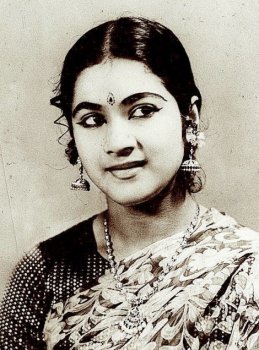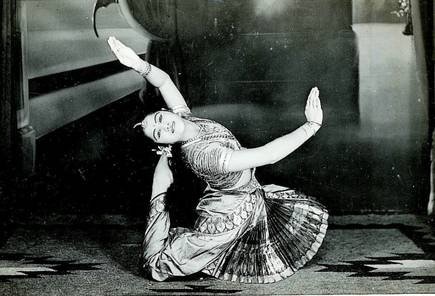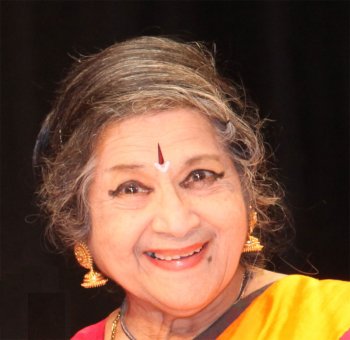
|
 |

|
 |
Kamala Lakshman, Bharatanatyam dancer & Guru - Lalitha Venkat e-mail: lalvenkat@yahoo.com Aug 2000  Born on June 16, 1934, with a career span of more than five decades on the stage and three on the silver screen, Kamala, the prime disciple of Natyacharya Vazhuvoor Ramiah Pillai, is acknowledged as the foremost exponent of the 'Vazhuvoor Bani', a style characterised by grace, finesse and aesthetic appeal. When did you start your dance career? I started learning kathak from Lachu Maharaj, Prof. More and Sunderprasad when I was 3 and half years old. My first performance was in 1939 in Mumbai at Astik Samaj when I was 5 years old. I remember it was on Sriramanavami Day. I also learnt Hindustani music from Shankar Rao Vyas. How did you switch over to Bharatanatyam? Film producer Chandulal Shah and his wife Gohar Bai who were pioneers in Indian films, made me a permanent child artiste for their studios in Mumbai for a handsome salary of Rs.100.00 per month. But like many other South Indians, we moved down South in 1942 when world war broke out. I was 7 when we came to Madanapalli where my guru Kattumannarkovil Muthukumarappa Pillai was giving classes. He was already nearly 60. I learnt a margam from him and gave a performance in Mayuram. When it became difficult for him to travel with me for performances, he recommended his relative Vazhuvoor Ramiah Pillai who was around 40 years old then. How did you balance your film and dance career? We came to Madras where I trained under Ramiah Pillai and performed in Mylai Samajam. Sriramulu Naidu saw my performance and booked me for 'Jagatalaprathapam'. AVM Studios contacted us and I worked for 10-15 films as a child star. Apart from films, I used to give 4 to 5 dance performances every month. Since I was already popular in films, there was a lot of demand to see my dance. Lalitha, Padmini, Ragini came much later..  You are famous for your stamina & for holding a pose for a considerable time. Do you take a special diet, do special exercises for that? I could hold a pose for half a minute. It's an inborn gift to me by God. People have asked me if I take any special meals for that. I'm a pure vegetarian. I used to do a lot of stretching and bending exercises. That's how I could do the Natharmudimel Irukkum Nalla Pambey which is my favorite as well as a favorite with the audience. Every morning, I used to exercise before going for make-up or shooting, also in the evening after returning from shooting if it was not too late. Whenever I found time, I used to work out for 1 or 2 hours at a stretch. That's how I developed my stamina. Were you the first dancer to do ardhanari on screen? No. I have danced the Shiva and Parvati dance with Gopi Krishna in the film 'Kathavarayan', In 'Naam Iruvar' I danced both roles with the camera trick. However, my student Vivek Ramakrishnan has performed the ardhanari role that I choreographed for him.  Many people feel you made a mistake in moving to USA, as out of sight is out of mind. Your comments. That's what many people say. During the MGR govt., I did not receive much encouragement. There was no support from the cultural organisations based in Delhi either, as the South is entirely ignored by them and despite going to Delhi and waiting to speak to the beaurocrats, nothing comes of it. Since I am very hard working and sincere to my art, this lack of encouragement hurt me deeply. In '78/79, I had gone to the US. There was need for a good teacher. So I left for the US in 1980. When I lost my husband in 1983, I was left to fend for myself. Many dancers consider you their manasiga guru, even though they never directly learnt from you, like Chitra Visweswaran & Anita Ratnam. I don't know why but many people like my dance and say that. I feel honored that they feel that way. What difference do you feel in today's dancers as compared to the old school - gurukulam style? To be coached by an aged dancer who is experienced in teaching makes a big difference. The gurukulam system is not feasible now. Many students are not grateful to teachers nowadays. There are many who learn, open their own schools and take away some students too along with them. I speak from experience. I'm still Indian in my thoughts and to find one's own people doing it is shocking. Do you find any difference in approach to dance by foreign students as compared to Indian students? Foreign students don't get the feeling of devotion. They are sincere in practice, take their work seriously, don't think 'this is enough'. They are a little stiff sometimes. Ballet means flexibility, a modern dancer is acrobatic. They are trained to speak with their bodies, without moving the muscles in their faces. So facial expressions are a little difficult for them. Footwork is also not their strong point. But when foreign students start learning Indian dance from their teens, these problems are minimal. How many male dancers in the US learn Bharatanatyam from you? Many are interested but I have only one male student Vivek Ramakrishnan and he's good. I have about 30 female students. I have a son who's in the military. He can play the mridangam, but he does not dance. What do you think of the present day students of dance? I think they are doing very well, are very hard working. There are some who are sincere and these are the people who excel. Which are the dance dramas that were staged in the USA that you like the best? 'Jaya Jaya Devi' was the best so far. 'Lakshmi Prabhavam' was not that good. I did not see 'Abhyaasa', so I can't say. I heard it was good. 'Annamacharya' was a total disappointment. What do you think of the craze Indian dancers in US have for performing in the December season in Chennai at their own cost? They need good reviews, which they have to submit back in the US in order to get grants which they use to produce their dance dramas. If you make a good name in your hometown, you can make it good anywhere. What do you think of the standard of critics in India? We have the best critics in India, especially Chennai. People who know their stuff and appreciate art. Though many foreign critics also write on Indian dance, some are knowledgeable, some are not. What do you feel about the awards being given by so many Sabhas nowadays? It's a kind of encouragement for the artistes to do more work, but it should be given only to artistes who deserve it, by people who know about dance, music and the value of service put in. Is it necessary to add one's title before one's name, like Kalaimamani or Nrithya Choodamani? Why not? What's wrong with it? I think it has more weight in the field. Only those who have not received a title would speak out against using it.  Do you think the classical styles should not be tampered with? In traditional dance, there are only a few movements. Each school emphasised on certain movements, like the Vazhuvoor bani, Pandanallur bani. Actually, Natya Sastra has movements applied in Odissi, belly dance, tap dance, Kathakali, Kathak and Manipuri also. Each state has adapted according to their language and way of living. When I sit and watch a dance program, I notice how a certain movement is different in Bharatanatyam, Mohiniattam or Kathak. What do you think of contemporary movements in Indian dance? They use Kalaripayattu, sometimes it is good. I saw "Annamaiyya". The boy who crawled across the stage like a snake....it was a nice contemporary movement. Narasimha avataram was a mix of Kathakali, Kuchipudi and kalari. It was interesting. Since the number of dancers has increased, so have the number of teachers. How do you rate them? Some are qualified, some are not. It's all jumbled up. Adyar Lakshman's group, K J Sarasa's group, C V Chandrasekhar's group, Sudharani Raghupathy's group, all are good.There's Padma Subrahmanyam's group too, but her style is good, only when she dances. Since you have your own school in the US, you must be doing very well. I've never got any grants despite applying. It's not true that teachers in US make lots of money by teaching dance alone. When both the husband and wife go to work, there is no problem and dance classes is an extra income. It's difficult for a single individual to make both ends meet solely by teaching dance. Do you have any health tips for up and coming dancers? Discipline is all in the mind. Accidents happen, they can't be avoided. I feel most dancers do take care. As parts wear out, problems are bound to arise. No extremities, never over-exercise any body part to prevent it from being worn out early. Do you have any unfulfilled ambition? I have received many awards like the 'Kalasikhamani' award of Tamil Nadu State in 1967-1968, the Central 'Sangeet Natak Akademi Award' in 1968 and the Presidential award of 'Padma Bhushan' in 1970, the 'E.Krishna Iyer Medal' instituted by the Sruti Foundation in 1989, the 'Nritya Choodamani' by Sree Krishna Gana Sabha in 1989, the prestigious 'Branta Professorship' in 1975 by the Colgate University, USA & 'Sangeeta Ratnakara' in 1993 by Bhairavi Fine Arts at the Cleveland Thyagaraja Aradhana, but I'm yet to get my Padma Vibushan. Also, I wanted to make a film based on my story. Not like a biography, but true incidents mixed with fiction. The audience will like that better as biographies could be boring! Comments * She was, is and will always be THE dancer who propelled my generation to throng the dance schools. - Anita Ratnam Post your comments Please provide your name and email id when you use the Anonymous profile in the blog to post a comment. All appropriate comments posted with name and email id in the blog will also be featured in the site. |